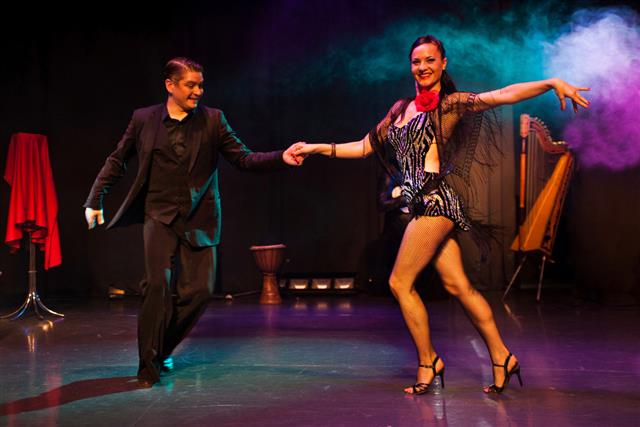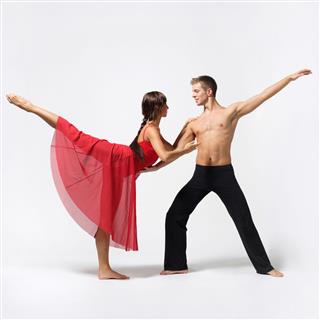
Ballroom dancing is the ultimate expression of power, poise, elegance, and romance. This DancePoise article brings you a list of different types of ballroom dance. Take a look!
|
Did You Know?
The term ‘ballroom dancing’ originated from a Latin word ‘ballare’, meaning ‘to dance’. And the first type of ballroom dance ever created was the Italian Viennese Waltz. |
Ballroom dance is one of the elegant and elite forms of dancing. The basic requirement for a dance to fall into the category of ballroom dancing is that it needs two people as partners to dance. The dances that fall under the umbrella of ballroom dancing have undergone constant change with additions and subtractions to the list over time. The list that exists now only pertains to the current time. Some dances that were accepted in the past, such as polka, schottische, one-step, and peabody, no longer find a place on this list of dance style. The most popular ballroom dances are waltz, tango, cha-cha-cha, Foxtrot, and jive.
There are currently two lists referred to when people talk of ballroom dances. One is the international style, that is further divided into International Standard and International Latin. In the US, the American Style consisting of American Smooth and American Rhythm, is widely accepted. While both these lists share a number of dances, and the techniques used are pretty similar too, International Standard allows only closed dance positions, whereas American Smooth allows closed, open, and separated dance movements. Let us have a look at them in detail.
International Style
| International Standard | International Latin |
| Slow Waltz | Cha-Cha-Cha |
| Tango | Samba |
| Viennese Waltz | Rumba |
| Slow Fox Trot | Paso Doble |
| Quick Step | Jive |
American Style
| American Smooth | American Rhythm |
| Waltz | Cha-Cha-Cha |
| Tango | Rumba |
| Foxtrot | East Coast Swing |
| Viennese Waltz | Bolero |
Tango
The tango has its roots in Argentina, with the current version incorporating European, American, Hollywood, and competitive (dancesport) influences into the style and execution of the dance. Soon after the Argentine tango arrived in Europe, it started gaining popularity, especially in Paris. The Europeans liked the seductive music and the passionate dance, and thus, slowly their style and technique became entwined with the original version. In order to have a standardized format which would be taught in dance schools and used in competitions, the English codified their own version, which took on the name International style. This is the version used in international dancing competitions.
The contemporary Viennese waltz is the original form of the waltz, and is a ballroom dance in the closed hold position. The waltz, which is alternately known as the English waltz and the slow waltz, is usually danced at about 90 beats per minute with three beats to the bar (the international standard of 30 measures per minute). In comparison, the Viennese Waltz is danced at about 180 beats (98-60 measures) a minute. An authentic Viennese waltz consists only of turns and change steps. In this dance, the couple frequently turn in a clockwise or anti-clockwise direction, interspersed with regular steps.
While there is ambiguity surrounding the exact origins of the Foxtrot, the name is attributed to its presumed creator, the vaudeville actor Harry Fox. In 1914, the dance caught the attention of the famous dancing couple Vernon and Irene Castle, who contributed to its popularity. However, it was Arthur Murray who was responsible for the standardized version that emerged a little later. The Foxtrot steadily gained popularity and peaked in the 1940s as the most popular fast dance. The slow version of the Foxtrot is now accepted in International style.
Waltz is one of the most romantic and popular ballroom dances of all time. It is considered as the ‘backbone’ of all dances on which many dances are based. It was developed as Austro-German folk dance in Germany, which was then called ‘Landler’. It is a smooth and flowing dance characterized by the rotating movements of both the dancers. It consists of the ‘rise and fall’ action that includes a three-step sequence of ‘step, slide, and step’. The steps are counted as ‘Quick-quick-quick’ or ‘1-2-3’. Because of its unique and distinguishable pattern of rhythm, it is easy to recognize and learn.
Cha cha cha is another playful and flirtatious dance style. It is passionate and energetic style that is quite similar to Rumba and Mambo. It originated in 1940s in Cuba and was developed as an adaptation of the Mambo and Rumba. It requires small steps and a lot of hip movements. It is danced in 4/4 beat and the fourth beat is split into two, giving the rhythm 2,3,4, and 1. Thus, five steps are danced to these four beats that becomes “One, two, cha cha cha”. The music involving this dance type is happy and creates a party-like atmosphere with 110-130 beats per minute because of its carefree and easy-going nature.
Jive is a happy and energetic dance that involves a lot of knee-lifting, bending, and hip-rocking. It is one of the fastest of the Latin dance forms, and requires lots of kicks and flicks that are well-controlled by the dancers. It is similar to East Coast Wing dance form. It first originated in the United States in the 1940s. It consists of two triple steps and one rock step. The rock step is counted as ‘1,2’ and the two triple steps are counted as ‘3 and 4’ and ‘5 and 6’. It can be danced to upbeat, swing, and rock and roll music with a tempo range of about 200 beats per minute.
Mambo is one of the favorite dance types throughout the world because of its high energy levels and contagious rhythm. It first originated in Cuba as a combination of Afro-Caribbean and Latin American dance. It has made its place not only friendly, social competitions, but also international dance competitions and cultures. It is basically based on forward and backward movements. It requires exaggerated hip movements combined with long, sharp, and quick steps. It uses 4/4 beat. The basic beats are counted as ‘quick-quick-slow’ wherein the feet moves on the second beat and the weight shifts to the other foot on the third beat, returning to the original position on the fourth. The music here involves rhythm that is set by various percussive instruments. The tempo varies between 32-56 beats per minute.
Rumba is dance form that tells a story between two lovers played by dancers. It is slow, romantic, and flirtatious with some serious notes as well. It originated in Cuba and was introduced in the United Sates in early 1920s. The distinctive hip movements that are required in this dance are an important part. The typical movements and sways are created by bending and straightening of the knees. The sharp eye contact between the dancers and stillness of the upper body is what increases the intensity of Rumba.The basic rhythm is ‘quick-quick-slow’ with exaggerated hip motion. The beats are 4/4 and one full step is considered complete after two sets of beats. The music tempo is about 104-108 beats per minute. This music is also sometimes enriched by using kitchen instruments such as pots, pans, and spoons.
Samba is considered as a dance of happiness and joy. It is lively and energetic. It originated in Brazil in the 19th century and was adopted as a ballroom dance only in 1930. Before it became a ballroom dance, it was mostly danced solo and is still a very popular dancer during celebrations and Carnival. A Samba dancer in Brazil is known as a Sambista. It is characterized by rapid steps that are taken on quarter beats along with the swaying and flowing motion of the dancers. The basic steps and rhythm involve fast, three-step weight changes with slight lifting of knees that is done with alternating footwork. The rhythm is ‘quick-quick-slow’ and tempo of the music is about 100 beats per minute.
With a large number of televised dance competitions, ballroom dancing is becoming increasingly popular. People are learning these dances as a means of exercise as well as recreation. Famous on-screen couples such as Fred Astaire and Ginger Rogers have contributed a great deal to the special place that ballroom dancing holds in our hearts. The grace and romance associated with these dances will never fade away.










